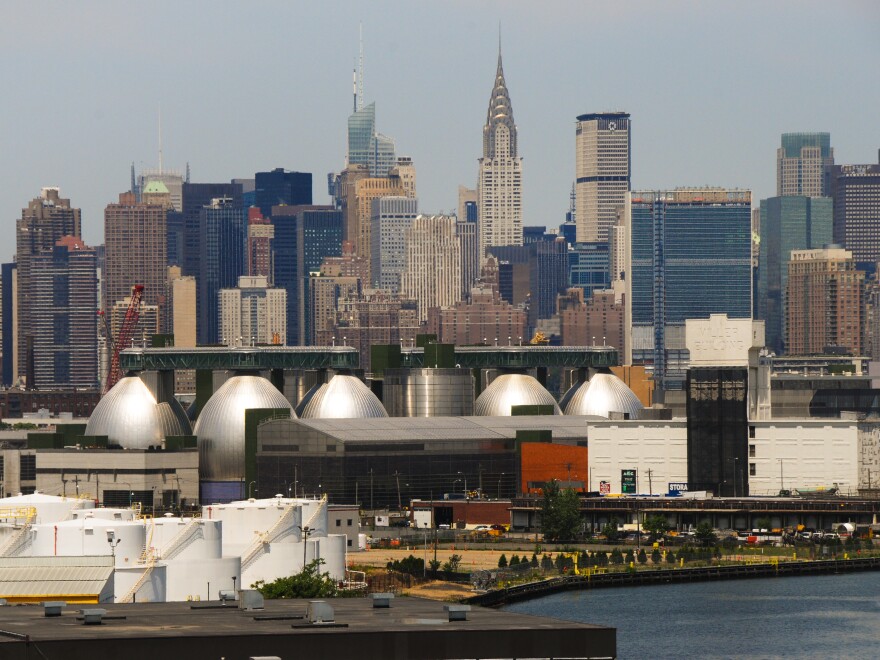Every year, Americans send millions of tons of food to the landfill. What if you could use all of those pizza crusts and rotten vegetables to heat your home? That's already happening in one unlikely laboratory: the Newtown Creek Wastewater Treatment Plant in Brooklyn.
The plant's longtime superintendent, Jimmy Pynn, shows off the plant's crown jewels: eight huge, shiny, oval-shaped steel tanks known as digester eggs. Each one contains millions of gallons of black sludge that's roughly the consistency of pea soup. Pynn calls it "black gold."
"It has a pungent odor to it," Pynn says. "To most people it's like ugly, yucky stuff."
Where others see foul and potentially hazardous sludge, Pynn sees a source of renewable energy, thanks to trillions of helpful bacteria inside the digester eggs.
"The digesters like to be fed like us: three times a day," he says. "They like to be kept warm, 98 degrees. And whether we want to admit it or not, we all make gas. And that's what we have these guys for: to make gas."

In this case, that gas is methane, which can be used to heat homes or make electricity. Right now, what these bacteria are digesting is mostly sewage sludge. But they're being introduced to a new diet: food scraps. The hope is that this plant will soon take in hundreds of tons of organic waste from houses and apartments.
"We could be taking all of Brooklyn's organics," says Ron Gonen, New York's deputy commissioner for recycling, "and rather than paying millions of dollars to send it to landfill, right here in Brooklyn, converting it into clean, renewable energy."
This is similar to what happens in your backyard compost heap — but here, the bacteria do their work without oxygen. It's called anaerobic digestion.
Anaerobic digestion isn't a brand new idea. What is new is the idea of adding food waste into the mix, at least in the U.S.
It's already being done in Europe, and a handful of cities in California and Canada are experimenting, as well as a famous theme park that creates a lot of food-related trash.
Paul Sellew heads Harvest Power in Waltham, Mass. It recently built a digester to handle the waste from the Walt Disney World Resort in Florida and the local community.
"Cardboard packaging, past-prime produce, rotten tomatoes, fats, oils, greases from fryers, past-prime dairy products and loaves of bread — those are all great food-stuffs for an anaerobic digester," says Sellew. "My microorganisms love that. That's their five-course meal."
But the operation at Disney has nothing on the complexity of implementing a food waste system in New York City.
"Everything in New York City is like big scale when you're talking about quantities of waste," says Samantha MacBride, a former New York sanitation official who's now a professor at the City University of New York's Baruch College.
"Right now, it's all in its infancy," says MacBride. "And it's a huge question mark about whether it can grow."
One challenge is how to separate the organic material from the rest of the trash in a city as dense as New York. "When you're in an apartment building, to separate out food scraps — it requires a lot of dedication and attention," says MacBride. "It doesn't have to stink, and it doesn't have to be inconvenient. But it takes extra work."
New York restaurants are about to find out just how much extra work next year.
In 2015, they will be required to stop sending their organic waste to landfills. And it is not yet clear where all that organic waste will go. For example, the digester eggs at Newtown Creek are just starting to take food waste. And they can only handle a small fraction of what's coming.
"It's the first, what I'll call the baby step," says Paul Sellew at Harvest Power. "Because ultimately in New York City, just the restaurants alone, you're talking well over a million tons a year," he says.
This fledgling industry is trying to build more compost plants and digesters to handle all of that waste, says Sellew. The costliest part may be finding good locations in or around the nation's biggest cities.
As for the trillions of bacteria? They'll work for free — as long as you feed them.
Copyright 2021 NPR. To see more, visit https://www.npr.org. 9(MDAxNzg0MDExMDEyMTYyMjc1MDE3NGVmMw004))








